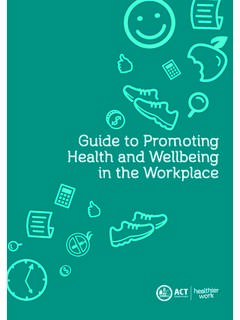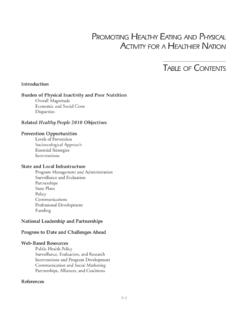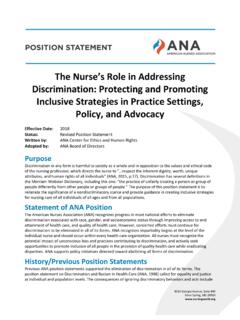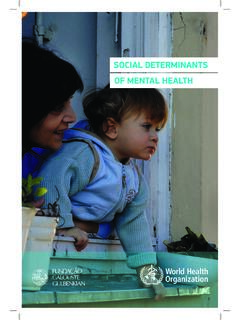Transcription of The impact of physical environments on employee wellbeing
1 The impact of physical environments on employee wellbeing topic overview physical environments and employee wellbeing About Public health England Public health England exists to protect and improve the nation's health and wellbeing , and reduce health inequalities. It does this through world-class science, knowledge and intelligence, advocacy, partnerships and the delivery of specialist public health services. PHE is an operationally autonomous executive agency of the Department of health . Public health England Wellington House 133-155 Waterloo Road London SE1 8UG. Tel: 020 7654 8000. Twitter: @PHE_uk Facebook: Core content provided by Robertson Cooper Ltd a firm of business psychologists that works across the private, public and government sectors. They specialise in helping organisations to achieve bottom-line improvements by enhancing wellbeing , engagement and resilience across their workforces, established by providing insight into the factors that drive these aspects of working life.
2 For queries relating to this document, please contact: Crown copyright 2015. You may re-use this information (excluding logos) free of charge in any format or medium, under the terms of the Open Government Licence To view this licence, visit OGL or email Where we have identified any third party copyright information you will need to obtain permission from the copyright holders concerned. Published August 2015. PHE publications gateway number: 2014819. 2. physical environments and employee wellbeing Contents About Public health England 2. Executive summary 4. 1 Introduction 7. 2 Methodology 9. 3 Office layout 10. 4 Office furniture 14. 5 Lighting and temperature 16. 6 employee control over the work environment 18. 7 Conclusion 20. References 22. 3. physical environments and employee wellbeing Executive summary The surroundings in which employees spend their working lives are an important source of job satisfaction and impact on work motivation and patterns of interaction.
3 They can be as much of a source of pressure as a heavy workload, poor work-life balance or significant organisational change. This report provides an overview of the literature around the impact of particular elements of the physical work environment on employee wellbeing , specifically the office layout, office furniture, workplace lighting and temperature and employee control over their work environment . All of these factors should be considered in order to ensure that the physical characteristics of the work environment do not have a detrimental effect on engagement, productivity and wellbeing . Summary of methodology This topic overview is one of four commissioned by Public health England (PHE). exploring certain priority but generally under-explored issues around health , work and unemployment. The target audience is a combination of local government, national organisations interested in health and work, and businesses themselves. The core content of this report was developed by RobertsonCooper Ltd using a search of relevant published and grey literature, and unstructured interviews with key informants.
4 Office layout Open plan and flexi' office types have the potential to increase collaboration, boost innovation and use space efficiently. However, it is important for organisations to integrate space for quiet, privacy and concentration in their office plans. Higher rates of sickness absence have been associated with a lack of perceived control and privacy at work. Office furniture Allowing employees flexibility in office furniture and working stations is associated with reduced sickness absence and greater job satisfaction. The evidence suggests that it is important to consider ergonomics, including adjustable chairs and desks. Lighting and temperature Both lighting and temperature have significant impacts on physical and psychological wellbeing in an open plan office, and managers should be proactive in addressing issues highlighted by staff. The quality and comfort levels of lighting can impact wellbeing , for example poor lighting levels can result in discomfort and fatigue.
5 An ideal office temperature was found to be 22-26 degrees Celsius, with those outside this range associated with worse performance and motivation. 4. physical environments and employee wellbeing employee control over the work environment Control at work is a key determinant of health and wellbeing . The extent to which employees perceive that they have control over their physical work environment has been associated with improved performance, job satisfaction and group cohesiveness. Conclusion Specific recommendations for action are made for each element of the physical work environment . Key recommendations Below are key recommendations for action under each of these elements of the physical work environment : Office design design office environments to accommodate the varying tasks and the specific needs of the workforce considering privacy in open plan offices, without compromising collaboration. Private spaces and quiet rooms should be available for those who require confidential conversations and focus.
6 Partitions allow for privacy and will mitigate noise and privacy concerns design work environments to foster opportunities for employees to easily connect and communicate. This fosters creativity supports employee innovation to facilitate quick and easy interaction and collaboration, relevant work stations should be positioned close to each other design work environments that go beyond the basic materials needed to do a job, to promote employee wellbeing and productivity provide a variety of work spaces for different types of working Office furniture furniture: promoting greater flexibility in terms of both the adjustability of equipment as well as different working options and considering the impact that furniture may have on musculoskeletal disorders, which are a huge contributor to work related absence chairs: researchers have identified several key features of an ergonomic chair design. They should be able to rotate and have an adjustable height of 38-54cm.
7 They should allow sufficient leg space and the ability to flex the knees by 90. degrees. They should have a backrest of 50cm to provide appropriate support Lighting and temperature where possible lighting levels should be adjustable, changes in lighting levels should be gradual and employees should have local control of lighting levels 5. physical environments and employee wellbeing maintain an office temperature of between 22-26 degrees Celsius Control over the work environment engage employees early in the process as it increases the likelihood they will buy into the process and provides an opportunity to gather their ideas. Methods should be wider than just another' staff survey use focus groups, short opinion polls and innovative ways of gathering staff perspectives control at work is a key determinant of health and wellbeing and perceived control over work environment is also important. This should be provided where possible General recognise the potential impact of the physical office environment beyond the legal requirements of the health and Safety Executive (HSE).
8 Engage staff in workplace design and where possible allow greater flexibility integrate evidence into practice, drawing on best and promising practice 6. Title goes here as running header 1 Introduction The surroundings in which employees spend their working lives are an important source of job satisfaction. They can be as much of a source of pressure as a heavy workload, poor work-life balance or organisational change. Recent figures on the economic case for wellbeing at work show the high rates of sickness absence due to stress, anxiety and The latest figures from the Labour Force Survey for 2011-12 show that 27 million working days were lost to sickness absence in total due to work related factors, million of which were the result of workplace stress, anxiety and depression, with a further million attributed to musculoskeletal disorders. While statistics vary depending upon their source and method of categorisation, a coherent picture of work-related stress is emerging and showing a trend that is on the rise.
9 Although work-related stress is not recognised as an illness in itself, it is a state that may result in ill- health . The physical environment that organisations provide for employees to carry out their work activities, most commonly in some form of office space, has been shown to have a powerful role in shaping a range of psychological and behavioural outcomes for Research by Robertson Cooper in 2010-13 found that 30% of employees were troubled by their physical working Further, employees who were troubled in this way were more likely to have a negative perception of their own levels of positive psychological wellbeing , physical and psychological health , and engagement, compared to those who were Considering the number of working days lost due to work-related ill- health , it is important for organisations to adopt a more holistic approach to supporting the health and wellbeing of their workforce, moving towards supporting employees to perform to the best of their ability.
10 This includes a need for organisations to take into account the impact of the office environment on health and wellbeing at work, as part of the wider work climate. As well as being a legal requirement under current health and safety law, provision of a suitable work environment for employees is a proactive step organisations can take to enhance the productivity of their workforce, as research estimates that the impact of offices on the personal productivity of occupants to be around 20%.4. In addition to the economic case, as with all health and wellbeing management policies, there exists an ethical argument for employees to have a work environment that is fit for purpose, enables performance and is not a source of unnecessary pressure. This report describes the impact of office layout, office furniture, workplace lighting and temperature and employee control over their work environment on employee wellbeing , and makes recommendations for policy-makers and businesses for action.
















